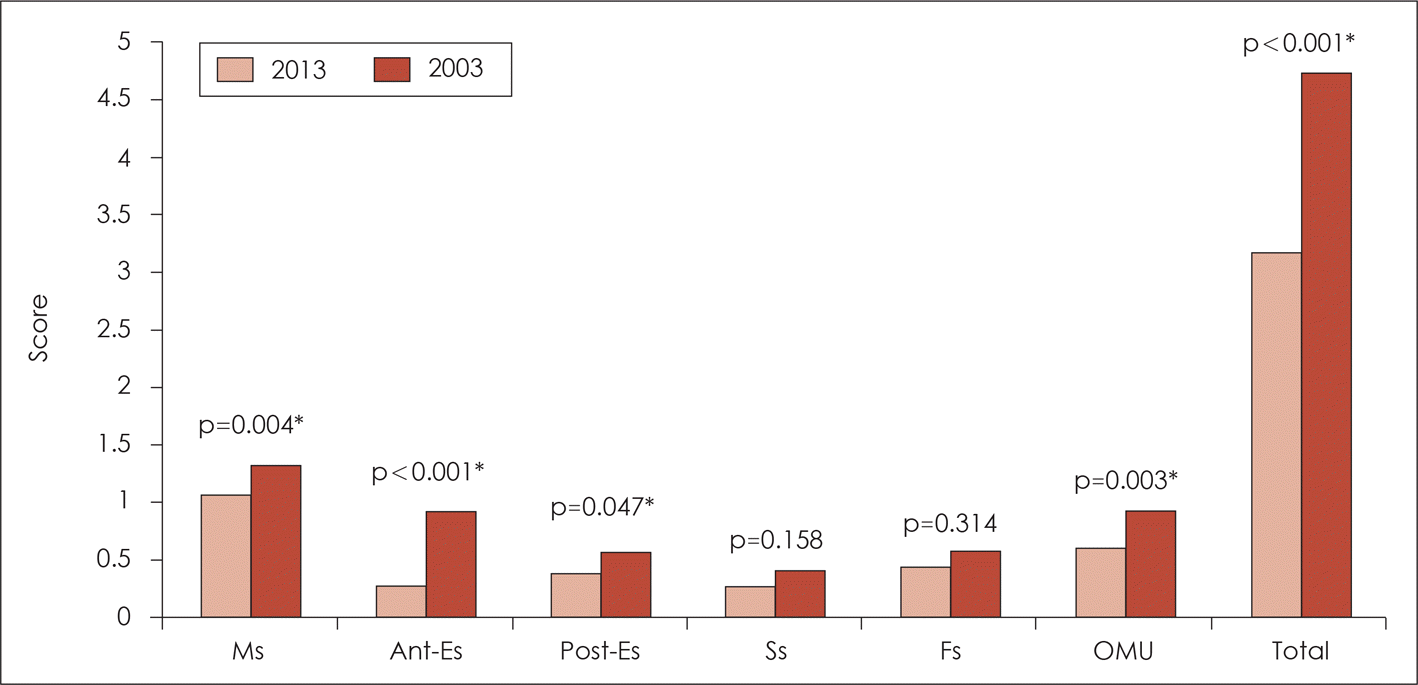Abstract
Background and Objectives
Endoscopic sinus surgery (ESS) was introduced to Korea in the 1980s and has since developed rapidly. There have been many changes in ESS over this period. Thus, in this paper, we explore trends in the clinical characteristics of ESS.
Subjects and Method
We retrospectively reviewed patients who underwent the ESS at 000 Hospital performed by a single surgeon at a 10-year interval. By comparing 106 patients who underwent ESS in 2003 and 108 patients who underwent ESS in 2013, we investigated changes in ESS in terms of the target group of surgical indications, CT scores, range of operation and complications.
Results
With regard to surgical indications, the proportion of patients who underwent surgery due to nasal polyps in 2013 (32.4%) was lower than in 2003 (59.4%), while the proportion of patients undergoing fungal sinusitis surgery in 2013 (13.9%) was higher than in 2003 (0.0%). In terms of preoperative CT evaluation, Lund-Mackay scores for the maxillary sinus, ethmoid sinus, and ostiomeatal unit were lower in 2013 than in 2003. The proportion of ESS performed only in the maxillary sinus in 2013 (20.0%) was higher than in 2003 (10.0%).
Go to : 
References
1). Chandra RK, Conley DB, Kern RC. Evolution of the endoscope and endoscopic sinus surgery. Otolaryngol Clin N Am. 2009; 42 (5):747–52.

2). Hemmerdinger SA, Jacobs JB, Lebowitz RA. Accuracy and cost analysis of image guided sinus surgery. Otolaryngol Clin N Am. 2005; 38(3):453–60.
3). Backous DD, Esquinel CR. Skull base medical and surgical issues commonly encountered in the practice of otolaryngology. Otolaryngol Clin N Am. 2005; 38(4):13–4.

4). Sellari-Franceschini S, Bennetive S, Santoro A, Nardi M, Mazzeo S, Bartalena L, et al. Orbital decompression in Grave's ophthalmopathy by medial and lateral wall removal. Otolaryngol Head Neck Surg. 2005; 133(2):185–9.

5). Setliff RC, Parsons DS. The hummer: new instrumentation for functional endoscopic sinus surgery. Am J Rhinol. 1994; 8(6):275–78.

6). Benson ML, Oliverio PJ, Zinreich SJ. Nasal and paranasal sinus imaging. J Belge Radiol. 1997; 80(2):89–91.

7). Lee JS, Shin SY, Lee KH, Kim SW, Cho JS. Change of prevalence and clinical aspects of fungal ball according to temporal difference. Eur Arch Otorhinolaryngol. 2013; 270(5):1673–7.

8). Kang BS, Kim NP, Lee WJ, Song HJ, Lee WY, Kim CA. Postoperative results of endoscopic sinus surgery in patients with chronic paranasal sinusitis. Korean J Otolaryngol. 1998; 41(2):203–7.
9). May M, Levine HL, Mester SJ, Schaitkin B. Complications of endoscopic sinus surgery: analysis of 2108 patients-incidence and pre-vention. Laryngoscope. 1994; 104(9):1080–3.
10). Tuncer U, Soylu L, Aydogan B, Karakus F, Akcali C. The effectiveness of steroid treatment in nasal polyposis. Auris Nasus Larynx. 2003; 30(3):263–8.

11). Pletcher SD, Goldberg AN. Treatment of recurrent sinonasal polyposis with steroid-infused carboxy methylcellulose foam. Am J Rhinol Allergy. 2010; 24(6):451–3.
12). Ophir D, Marshak G. Removal of antral polyp through an extended nasoantral window. Laryngoscope. 1987; 97(11):1356–7.

13). Kwon SH, Yang YS, Min YG. Surgical treatment and clinical study of postoperative maxillary Cyst. Korean J Otolaryngol. 1997; 40(8):1115–21.
14). Park HW, Lee BJ, Jang YJ, Chung YS. Postoperative Mucoceles of Frontal, Ethmoid, or Sphenoid Sinus. J Rhinol. 2007; 14(1):16–20.
15). Min YG, Kang MK, Lee JW, Choo MJ, Lee KS. A clinical study of mycotic sinusitis. Korean J Otolaryngol. 1993; 36(2):292–301.
16). Kim SW, Park YJ, Kim SW, Kang MG, Joo YH, Cho JH. A clinical analysis of fungal sinusitis. Korean J Otolaryngol. 2005; 48(3):332–7.
17). Jeong JH, Kim KT, Chung SK. The Role of Otolaryngology in Dental Implantation. J Rhinol. 2008; 15(2):83–91.
Go to : 
 | Fig. 1.Lund-Mackay scoring system of endoscopic sinus surgery in 2013 and in 2003. Ms: Maxillary sinus, Ant-Es: Anterior Ethmoid sinus, Post-Es: Posterior Ethmoid sinus, Ss: Sphenoid sinus, Fs: Frontal sinus, OMU: Ostiomeatal Unit. *: <0.05. |
Table 1.
Demographics of endoscopic sinus surgery in 2013 and in 2003
| 2003 | 2013 | p-value | |
|---|---|---|---|
| Number of patients | 106 | 108 | – |
| M: F | 62: 44 | 53: 55 | 0.119 |
| Mean age | 46.2±17.2 | 44.8±19.0 | 0.745 |
| (29.0–63.4) | (25.8–63.8) |
Table 2.
Indications of endoscopic sinus surgery in 2013 and in 2003
| Indications | 2003 (%) | 2013 (%) | p-value |
|---|---|---|---|
| Nasal polyposis | 59.4* | 32.4 | <0.001 |
| Refractory to medical treatment | 17.0 | 18.5 | 0.721 |
| Fungal sinusitis | – | 13.9* | <0.001 |
| Sinus mucocele | 06.5 | 12.0 | 0.108 |
| POCC among sinus mucocle | 04.7 | 7.4 | 0.391 |
| Antrochoanal polyp | 02.8 | 6.5 | 0.195 |
| Recurrent sinusitis | 07.5 | 3.7 | 0.247 |
| Tumor | 00.9 | 3.7 | 0.175 |
| Foreign body removal | – | 0.9 | 0.316 |
| CSF leakage | – | 0.9 | 0.316 |
| Orbital decompression | – | – | – |
Table 3.
Range of endoscopic sinus surgery in 2013 and in 2003
| Paranasal sinuses | 2003 (%) | 2013 (%) | p-value |
|---|---|---|---|
| Ms+ Es+ Fs | 50.0%* | 24.6% | <0.001 |
| Ms+ Es | 32.5%* | 23.1% | 0.169 |
| Ms only | 10.0%* | 20.0%* | 0.037 |
| Ms+ Es+ Ss | – | 04.6% | 0.060 |
| Ms+ Es+ Fs+ Ss | 05.0%* | 03.1% | 0.471 |
| Ss | – | 01.5% | 0.155 |
| Ms+ Ss | – | 01.5% | 0.155 |
| Es+ Fs | – | 01.5% | 0.155 |




 PDF
PDF ePub
ePub Citation
Citation Print
Print


 XML Download
XML Download